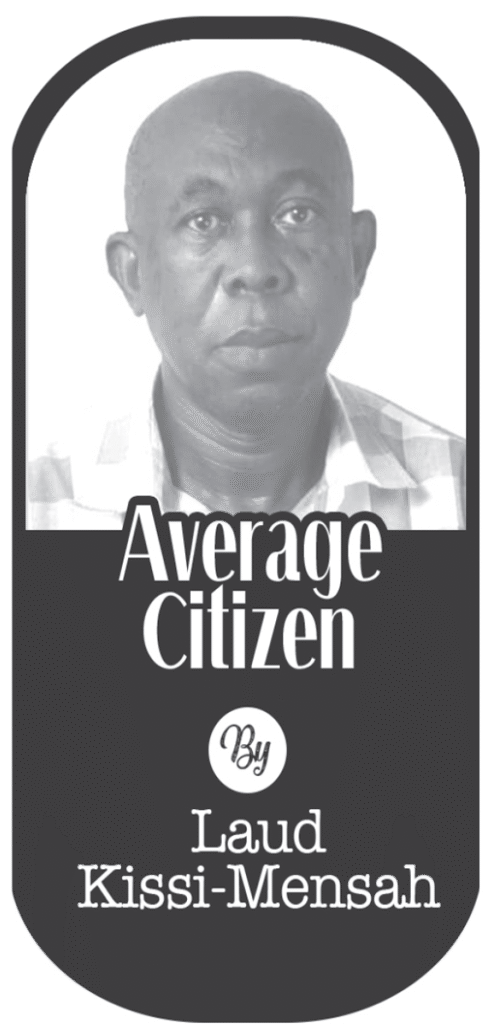Features
The Water Palaver

When Ghanaman is relaxing at home and hears a knock at the door, he is likely to suspect that a Jehovah Witness man show him the best tax-free way to heaven. If it is not the Jehovah Witness man with the black bag, then it must be the landlord coming to talk nonsense.
“Yes, come in.” “You owe us ¢350,000 in water bills. We’re in to disconnect.”
“Wait a minute. Your presence is giving me heart attack, so come back later for payment.
Fact is I’m allergic to water bills.”
Some people don’t care a damn about electricity disconnection. No light, so what? What they are scared about is water cuts. They can cause instant diarrhoea. And soon, water and electricity costs are going to be increased, and an epidemic of diarrhea is highly expected.
It is, however, very difficult to disconnect some consumers because they make conscious efforts not to get cut off.
One favourite method is to train a dog which can detect a disconnector from a normal human being and do the chasing out accordingly. The dog must have appetite for human leg or human balls.
Another way is to allow yourself to be disconnected and then you can go to the water or electricity company, dressed in suit with a deep-frown on your face. That is where you can blow your horn.
“The interior minister is my brother-in-law. I command you by state power to reconnect me before I change gears. You don’t respect? If you don’t know me go and ask. Kofi Annan was my classmate. If you play, I’ll deal with you at the United Nations level.”
Sometimes, officials can take the bluff as very authentic and proceed to re-connect Kofi Annan’s classmate. But others will feel they are doing their job and the interior-minister’s in-law’s big mouth has nothing to with the execution of official assignments.
“Well, we know the Interior-Minister is related to you. But the bill must be settled anyway. If you can settle half, we’ll re-connect and give you time to settle the rest.”
It turns out that the man finally settles the bill, but doesn’t even know how Kofi Annan like.
As for his relationship with the interior Minister, it can only be at best, a dog’s imagination.
At any rate, Ghanaians are waiting for the new utility rates and are also hopeful that a corresponding raise in salary will be in place to absorb the shock.
Now Electricity Company and Ghana Water Company have many problems they would have to solve. One of them is waste. With electricity, illegal connections are very common and many are using power and paying nothing for it.
Others are using air-conditioners and pay nothing because they connect the wires in such a way that power used does not go through the meter and is, therefore, not recorded. What the company loses in a month countrywide is so huge that if it can be recovered, the company would be on rather good footing
The problem also is that, consumers who are disconnected have become wiser than the serpent. Some have taught themselves Basic Principles in Electricity. Many housewives know the principles better than any electrical engineer at ECG.
When you disconnected power to their homes, they simply wait for five minutes and reconnect. No sweat!
It is a simple procedure they have repeated so many times that they are no longer worried about and disconnection.
So bills pile up and ECG is helpless, and goes whining about the need to increase tariffs without really tackling the waste problem.
With water, it might be worse. People have illegal connections through which they sell water for their own pockets. Some pipes have burst for over six months and no one is bothered. People report leakages and no one is worried.
Ghana Water Company is not doing well because of waste. You can’t import expensive chemicals to purify water and let it go waster. No company can thrive on a system that is not bothered about waste.
So Ghana Water Company better wake up and save water. In some countries, water is imported. If we have it here, we should learn to conserve it.
Features
Ghana becoming a developed nation — Part 4
Having initiated programs to ensure a foundation of morality, the next step is to have a picture of what success looks like. I keep saying that if you do not have a destination in mind when travelling, you can never arrive.
We therefore as a people, need to set up a development plan which all parties shall ascribe to so that no matter which party is in government, the execution of the plan will not be derailed.
This is the only way that we can make a headway in our developmental agenda. Once we have a plan we are following, it becomes a guiding tool to arrive at the destination we have set for ourselves. It becomes a project that given the necessary key milestones, will help us in monitoring progress.
The next step is to focus on pillars of development i.e. education, health, agriculture and the economy.
The common characteristic of developed countries is the level of education of its citizens.
A highly educated population provides readily available human resource for industrial growth.
A highly qualified population has the potential to innovate, creating value added products for export.
A healthy population is necessary for development. Proactive measures that can prevent epidemics for instance, must be put in place to ensure a healthy populace.
This would require a deliberate investment in health infrastructure as well as training of professionals in the health sector.
Food must be available and must also be affordable and there policies that can ensure the achievement of this objective must be vigorously pursued.
Agro-processing must be prioritised if not completely eliminate post harvest losses and also provide goods for export as part of the effort to stabilize currency.
The power of a nation depends largely on its economic growth. The reason why countries like the US and China wield a lot of influence in the world is because of their wealth.
The way out of poverty as a country, is to industrialise. We need to focus on deliberate effort to promote indigenous control over our natural resources so as to reduce repatriation of huge foreign currency out of the country.
Such initiatives will provide or make available funds for entrepreneurs to access for industrialisation. If we do not prioritise industrialisation, we will permanently not enjoy real independence as a nation because we will have to depend on them to assist in funds for our budget deficit.
Whoever controls how you run your budget literary controls you and therefore the countries who provide budgetary support, controls us. We need to get out of this situation so we can be truly.
The industrialisation cannot be established without companying infrastructure and therefore infrastructure development must be taken seriously into account.
Local expertise must be sought in the infrastructural development. The use of local expertise will help create jobs for the teeming youth the universities churn out every year.
I hope to complete this series next weekend. God bless.
NB: ‘CHANGE KOTOKA INTERNATIONAL AIRPORT TO KOFI BAAKO INTERNATIONAL AIRPORT’
Join our WhatsApp Channel now!
https://whatsapp.com/channel/0029VbBElzjInlqHhl1aTU27
Features
The impact of emotionalsurgery and emotional elysiumon presidential performance
AS the world becomes increasingly complex, the role of a president has become more demanding than ever.
The pressure to make life-altering decisions, manage crises, and maintain a sense of calm and composure can take a toll on a president’s mental health.
In recent years, innovative approaches like emotional surgery and emotional elysium have gained attention for their potential to support leaders in managing stress and promoting emotional well-being.
Understanding emotional surgery
Emotional surgery is a groundbreaking approach that utilises art to promote relaxation and reduce stress.
This technique involves the use of colors, geometric shapes, and abstract objects to communicate with the brain and induce a state of calmness.
By leveraging the brain’s ability to process visual information, emotional surgery can help individuals manage anxiety and stress, promoting a sense of calmness and well-being.
The benefits of emotional elysium
Emotional elysium refers to practices that promote emotional well-being and resilience.
This approach focuses on cultivating positive emotions such as gratitude, compassion, and love, to improve overall well-being.
For presidents, emotional elysium can be particularly beneficial in managing the stresses of office and promoting emotional balance.
By incorporating emotional elysium practices into their daily routine, presidents can improve their emotional regulation, increase their resilience, and enhance their overall well-being.
The impact on presidential performance
Both emotional surgery and emotional elysium have the potential to significantly impact a president’s performance.
By managing stress and promoting emotional well-being, presidents can:
- Improve decision-making: Emotional surgery and emotional elysium help presidents make more informed, rational decisions, rather than reacting impulsively to stress or emotions.
- Enhance leadership: Leaders who prioritise emotional well-being are better equipped to build strong relationships with their team and the public.
- Increase resilience: Emotional elysium practices, such as mindfulness and meditation, build resilience, enabling presidents to cope better with challenges and setbacks.
Prof. Agyeman Badu Akosa’s endorsement
Prof. Agyeman Badu Akosa, a respected figure in the medical field, has endorsed emotional surgery as a valuable tool for promoting relaxation and reducing stress.
According to him, emotional surgery can reduce anxiety, improve emotional regulation, and enhance overall well-being.
Conclusion
In conclusion, emotional surgery and emotional elysium are two innovative approaches that have the potential to significantly impact a president’s performance.
By prioritising emotional well-being and exploring these approaches, presidents can improve decision-making, enhance leadership, and increase resilience.
As global challenges become more complex, it is essential for presidents to safeguard their mental health — and these techniques offer a promising solution.
Recommendations
- Presidents should prioritise their emotional well-being: Recognising the importance of emotional balance allows leaders to manage stress effectively.
- Emotional surgery and emotional elysium should be considered: These approaches may offer promising solutions for high-end executives whose emotional well-being affects their performance.
By embracing emotional well-being and exploring innovative interventions, presidents can optimise performance, build stronger relationships, and promote overall well-being.
Join our WhatsApp Channel now!
https://whatsapp.com/channel/0029VbBElzjInlqHhl1aTU27












